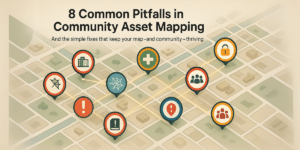What is organizational network analysis and why is it so useful?

You may have heard of a new methodology called organizational network analysis. It’s a similar process to social network analysis… but what is ONA, and why is it useful? It’s essentially a way of studying relationships using a network science lens. Here’s more complete explanation of the process, why it matters, how to conduct it, and some of our favorite tools and software to help you succeed.
First of All, What is Organizational Network Analysis?
Put simply, organizational network analysis is a method for studying communication and socio-technological networks within and between organizations. For example, you could use ONA to study interactions and communication between different departments within a single organization. You can also use it to research how numerous independent organizations work together and collaborate to reach shared goals. By focusing on the quality and structure of connections, as opposed to each organization itself, we can identify powerful insights that drive impact and better outcomes.
What Can ONA Teach Us?
Hold up. You’re probably wondering, “how does this actually work in practice? What can I learn from organizational network analysis?” The sky is the limit, as ONA is a flexible method you can use for many different applications. When we use ONA to better understand community partnership networks, we can identify new forms of value and resources to leverage across partners. We can reduce our redundant ties to collaborate more efficiently, while identifying weak ties that lack trust to target for more relationship-building work. Now that you understand organizational network analysis, you probably also see why it can be useful.

How Do You Conduct an Organizational Network Analysis?
While there are a lot of different specific ways to go about an organizational network analysis, there are generally a few key steps. First, you have to bound your network and create a list of organizations and people from each to collect data from. Second, you should write your survey and questions. Picking these are important, as your data is only as good as the questions you ask. In most of our projects, we use our validated 19-question community partner survey. Finally, you send your surveys and collect data, which you analyze by creating maps and network science metrics. These provide insights and opportunities to collaborate more effectively.
Best Organizational Network Analysis Tools and Software
Curious about conducting your own organizational network analysis? Today you have more options available on the market than ever before. There are a number of free options like Gephi and Unicet however they require you to collect your data elsewhere and a significant amount of time to clean your data and learn to use the software. We created the PARTNER Platform to provide a better alternative: An all-in-one solution that includes survey tools, email system, network analyzer and report builder all in one software. Learn more about PARTNER here, or watch a demo here.
Now You Know the Power of Organizational Network Analysis!
Now that you can answer the original question, you’re ready to get started! Sign up for a free trial to try out PARTNER or explore our full Network Resource Library for free. Interested in learning more about our tools or services? Reach out to us to learn more or setup a time to talk.

About the Author: Alex Derr, M.P.A.
Director of Marketing & Communications
Alex joined VNL in 2017, originally supporting our events. He now helps manages our communications and marketing strategy and content development work. Alex creates blogs, infographics, reports, and other content while managing our web and social media presence. He also runs our email marketing campaigns, tracks analytics, and conducts market research to drive our strategy. He supports our entire team with copywriting, graphic design and research, and helps with events, webinars, demos, and other online learning. When he isn’t at work Alex spends his time climbing 14ers (30 done, 28 to go!) and blogging on his own website, The Next Summit Blog.




